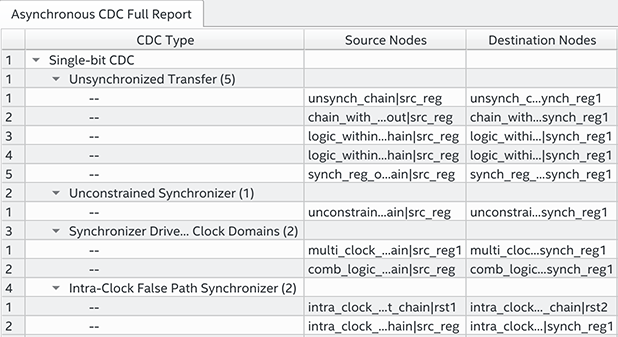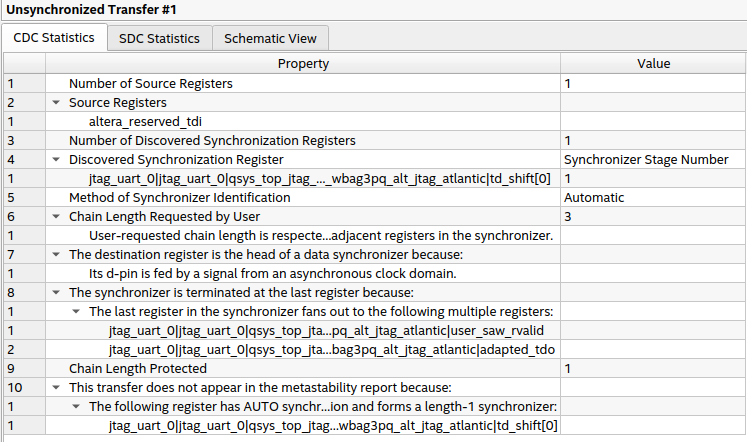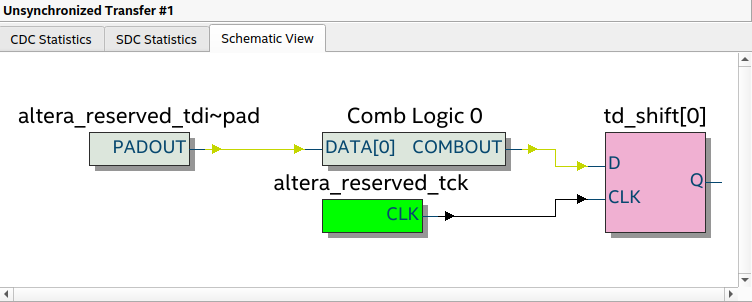Visible to Intel only — GUID: ewv1615896287447
Ixiasoft
Visible to Intel only — GUID: ewv1615896287447
Ixiasoft
2.5.10. Report Asynchronous CDC
SDC Statistics Tab
| Settings | Description |
|---|---|
| Clocks | Filters the report to only show CDCs that originate from From clock and terminate at To clock. |
| Targets | Filters the report to only show CDCs that originate from From register and terminate at To register. Both the From and To must be registers. This option is optional with the Clocks option. |
| Entries | Limits the number of entries that are reported per CDC category |
| Detail | Chooses whether to show a summary of all CDC’s or give detail on each individual CDC |
| CDC Categories | Specifies the CDC categories to be reported, including Single-bit CDC, Multi-bit CDC, and Reset CDC options. |
| Report panel name | Specifies the name of the report panel. You can optionally enable File name to write the information to a file. If you append .htm or .html as a suffix, the Timing Analyzer produces the report as HTML. If you enable File name, you can Overwrite or Append the file with latest data. |
| Tcl command | Displays the Tcl syntax that corresponds with the GUI options you select. You can copy the command from the Console into a Tcl file. |
The summary view of the Asynchronous CDC Report provides an overview of the number of CDC’s that fall into each category in your design. CDC Count gives the number of topologies detected for a category. Total Transfer Width shows the total number of CDC crossings for a category. This value is different than CDC Count for multibit CDC’s because each topology consists of multiple crossings.
The full view of the Asynchronous CDC report shows the source and destination registers and clocks for each detected CDC topology in your design. You may click on any row of this report. Clicking on a row that contains the name of a CDC category brings up the description for that category and associated Design Assistant rules that check for such topologies.

In the Asynchronous CDC Full Report tab, the All Source Clocks (Synch/Asynch) column displays all clocks driving all source nodes of a synchronizer chain, regardless of whether the transfers are synchronous or asynchronous. There can be asynchronous and synchronous transfers into the head of a synchronizer chain if the paths go through combinational logic before the head of the synchronizer chain. For example, Figure xx shows a circuit with both asynchronous and synchronous transfers into a synchronizer chain. For this example, the Asynchronous CDC Full Report lists both clkA and clkB as source clocks of the synchronizer chain, even though clkB is a synchronous transfer.
Clicking on a row that contains a CDC displays detailed information on that CDC in the CDC Statistics, SDC Statistics, and Schematic View tabs. These tabs help you to more easily identify the root cause of inefficient CDC design by showing both the relevant topology and related SDCs together in one view.

The SDC Statistics tab lists all the SDCs that are related to the CDC that you select from the report.

The Schematic View tab allows you to visualize the structure of the CDC. You can readily identify the head of the synchronizer chains, the synchronizer registers, and the clocks of each register.
